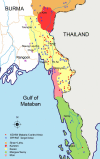Prevalence of Plasmodium falciparum in active conflict areas of eastern Burma: a summary of cross-sectional data
- PMID: 17803819
- PMCID: PMC2034373
- DOI: 10.1186/1752-1505-1-9
Prevalence of Plasmodium falciparum in active conflict areas of eastern Burma: a summary of cross-sectional data
Abstract
Background: Burma records the highest number of malaria deaths in southeast Asia and may represent a reservoir of infection for its neighbors, but the burden of disease and magnitude of transmission among border populations of Burma remains unknown.
Methods: Plasmodium falciparum (Pf) parasitemia was detected using a HRP-II antigen based rapid test (Paracheck-Pf(R)). Pf prevalence was estimated from screenings conducted in 49 villages participating in a malaria control program, and four retrospective mortality cluster surveys encompassing a sampling frame of more than 220,000. Crude odds ratios were calculated to evaluate Pf prevalence by age, sex, and dry vs. rainy season.
Results: 9,796 rapid tests were performed among 28,410 villagers in malaria program areas through four years (2003: 8.4%, 95% CI: 8.3 - 8.6; 2004: 7.1%, 95% CI: 6.9 - 7.3; 2005:10.5%, 95% CI: 9.3 - 11.8 and 2006: 9.3%, 95% CI: 8.2 - 10.6). Children under 5 (OR = 1.99; 95% CI: 1.93 - 2.06) and those 5 to 14 years (OR = 2.24, 95% CI: 2.18 - 2.29) were more likely to be positive than adults. Prevalence was slightly higher among females (OR = 1.04, 95% CI: 1.02 - 1.06) and in the rainy season (OR = 1.48, 95% CI: 1.16 - 1.88). Among 5,538 rapid tests conducted in four cluster surveys, 10.2% were positive (range 6.3%, 95% CI: 3.9 - 8.8; to 12.4%, 95% CI: 9.4 - 15.4).
Conclusion: Prevalence of plasmodium falciparum in conflict areas of eastern Burma is higher than rates reported among populations in neighboring Thailand, particularly among children. This population serves as a large reservoir of infection that contributes to a high disease burden within Burma and likely constitutes a source of infection for neighboring regions.
Figures


References
-
- Rojanawatsirivet C, Congpuong K, Vijaykadga S, Thongphua S, Thongsri K, Bangchang KN, Wilairatana P, Wernsdorfer WH. Declining mefloquine sensitivity of Plasmodium falciparum along the Thai-Myanmar border. Southeast Asian J Trop Med Public Health. 2004;35:560–565. - PubMed
-
- Wongsrichanalai C, Sirichaisinthop J, Karwacki JJ, Congpuong K, Miller RS, Pang L, Thimasarn K. Drug resistant malaria on the Thai-Myanmar and Thai-Cambodian borders. Southeast Asian J Trop Med Public Health. 2001;32:41–49. - PubMed
-
- Dondorp AM, Newton PN, Mayxay M, Van Damme W, Smithuis FM, Yeung S, Petit A, Lynam AJ, Johnson A, Hien TT, McGready R, Farrar JJ, Looareesuwan S, Day NP, Green MD, White NJ. Fake antimalarials in Southeast Asia are a major impediment to malaria control: multinational cross-sectional survey on the prevalence of fake antimalarials. Trop Med Int Health. 2004;9:1241–1246. doi: 10.1111/j.1365-3156.2004.01342.x. - DOI - PubMed
-
- World Health Organization Regional Office for South-East Asia . Malaria: Disease burden in SEA region. New Delhi ; 2005.
LinkOut - more resources
Full Text Sources

